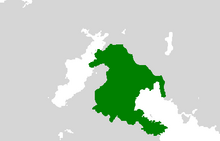User:Devink/sandbox3: Difference between revisions
No edit summary |
|||
| Line 141: | Line 141: | ||
===Convertion to Christianity=== | ===Convertion to Christianity=== | ||
Kando II's decision of submitting to pagan rulers was contested and criticized in both of his realms, leading to protests and insurections. To stabilize their rule in the newly conquered regions, Tugan Khan, greatson of Olig Kuz, decided to convert to {{wp|Orthodox Christianism|Christianity}}. It was the beginning of a long lasting alliance between the {{wp|Orthodox Christianism| | Kando II's decision of submitting to pagan rulers was contested and criticized in both of his realms, leading to protests and insurections. To stabilize their rule in the newly conquered regions, Tugan Khan, greatson of Olig Kuz, decided to convert to {{wp|Orthodox Christianism|Christianity}}. It was the beginning of a long lasting alliance between the {{wp|Orthodox Christianism|Iconodulist Orthodox Church}} and the Tümen. | ||
===Wars against the Lushyodorstag=== | ===Wars against the Lushyodorstag=== | ||
Revision as of 11:07, 29 August 2020
Great State of the Tümen Ikh Tümen Uls | |||||||||
|---|---|---|---|---|---|---|---|---|---|
| 1145–1700 | |||||||||
 | |||||||||
| Status | Kingdom | ||||||||
| Religion | Sünsnüüd Orthodox Christianity | ||||||||
| Khan | |||||||||
• Military Assembly | Assembled Thousand | ||||||||
| History | |||||||||
• Migration of the Tümen eastward | 1145 | ||||||||
• Disestablished | 1700 | ||||||||
| |||||||||
The Great State of the Tümen, more commonly known by their nickname of Neo-Bayarids was originally a Bayarid Khanate originating in the northwestern sector of the Empire before becoming a functionally separate khanate. It was founded by Olig Kuz, a Bayarid Myriarch serving as the commander of the fortification of the North-Western border. During the collapse of the Empire Olig Kuz, with the help of local vassals or bordering states, established his own Khanate which became known as the "State of the Ten Thousand Warriors". Olig Kuz would continue to solidify his rule, defeating both other Bayarid rivals and oportunistic neighbors. The power of the Tümen peaked during the 13th century, when its territories included a vast stretch of lands from Lake Kulpanitsa in the west to Boika in the east and dominated most of modern Drevstran.
History
Bayarid Origin
Participation in the Ikonkivoyra
The Grand Ikonkivoyra lasted for 230 years, between 1020 and 1260, and saw the Sevromark becoming one of the major powers in Eastern Belisaria, pushing back the Lushyods and conquering most of the Duchy of Yugstran. Desesperate, Duke Kando II reached out to the Tümen Khan for help against its Iconoclast rival. After quick negociations, the Khan agreed to join the war in exchange of Kando's alliegeance. The combined Tümen-Yugstraneses forces quickly and repeatedly defeated the Sevromark in battle, killing King Kzvar III in battle in 1256 and capturing his son and successor three years later. The kingdom ended when the nine years old Abran was forced to renounce his title and convert to Orthodoxy. He died four years later without heir as a captive of the Seredinian court.
Following Abran's abdication, the Sevromark was reorganized into the Duchy of Drevstran, offered to Kando II while his duchy of Yugstran was elevated to the status of a principality.
Convertion to Christianity
Kando II's decision of submitting to pagan rulers was contested and criticized in both of his realms, leading to protests and insurections. To stabilize their rule in the newly conquered regions, Tugan Khan, greatson of Olig Kuz, decided to convert to Christianity. It was the beginning of a long lasting alliance between the Iconodulist Orthodox Church and the Tümen.
Wars against the Lushyodorstag
Culture
Like the Bayarids before them, horses were central for the Tümen's way of life and culture. Their main activity was animal husbandry, raising horses, sheep, goats, and cattles. After the creation of their state, they began to lead a semi-settled life and took part in trading and farming, as well as blacksmithing, furriery, shoe making, saddle making, bow making, and clothes making. They mainly sold and exported animals, mostly horses, and animal products. They wore sheepskin and were armed with composite bows and arrows. Their traditional diet consisted of soup with millet and meat and included beer, curdled mare's milk, and bread.
The fundamental unit of Cuman society was the family, made up of blood relatives. The Tümen are remarkable among post-Bayarids societies in that they did not have a clanic structure. Indeed, the origin of the Tümen is to be found in the diverse Bayarid garrisons on the western border of the Empire, and thus their tribal origins, while remembered, became overshadowed by the Garrison/Fortress/Banner they were attached to. With time, this became an identification with the city, the settlement they were from, further diluting their Bayarid heritage in the culture of the lands they conquered.